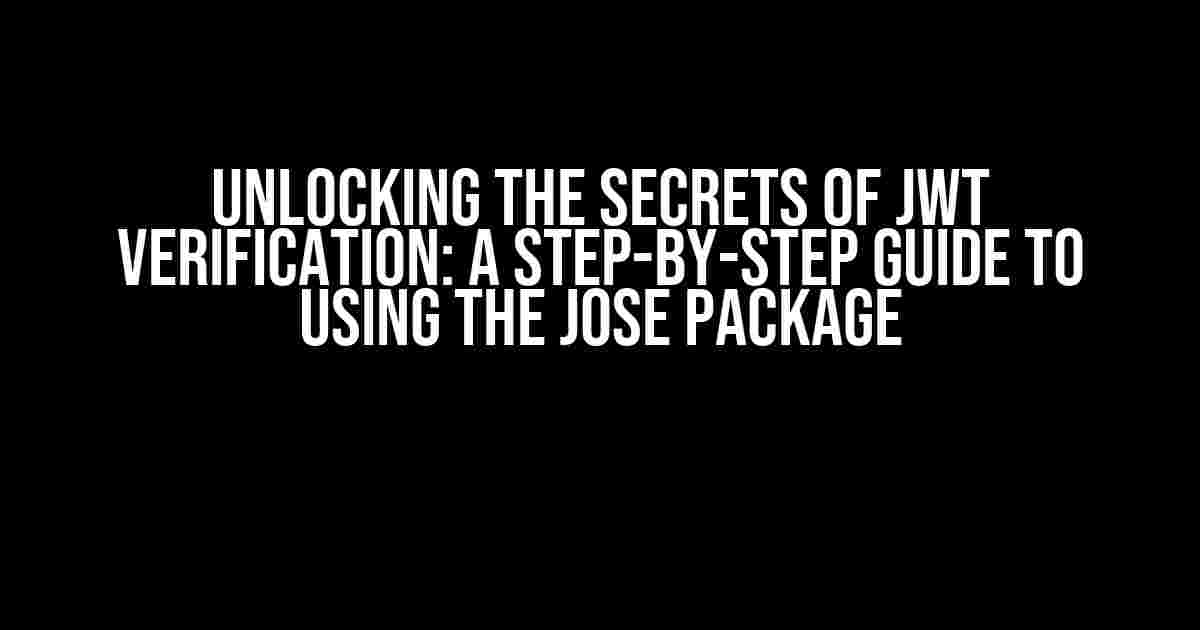JSON Web Tokens (JWTs) have revolutionized the way we handle authentication and authorization in modern web applications. But, have you ever wondered how to verify the authenticity of an encrypted JWT? Look no further! In this comprehensive guide, we’ll delve into the world of JOSE (JSON Object Signing and Encryption) and explore how to use the JOSE package to verify an encrypted JWT.
What is JOSE and Why Do We Need It?
JOSE is a set of algorithms and data structures for securely transmitting information between parties. It’s an extension of the JSON Web Signature (JWS) and JSON Web Encryption (JWE) specifications. JOSE provides a standardized way to encrypt and sign data, ensuring its integrity and authenticity. In the context of JWT verification, JOSE is essential for validating the token’s authenticity and ensuring it hasn’t been tampered with.
Why Verify an Encrypted JWT?
Verifying an encrypted JWT is crucial for several reasons:
- Authentication**: Verify the user’s identity and ensure they have access to the requested resources.
- Authorization**: Validate the user’s permissions and ensure they can perform the desired action.
- Security**: Prevent unauthorized access and protect against token tampering or manipulation.
Getting Started with the JOSE Package
To use the JOSE package, you’ll need to install it in your project. You can do this using npm or yarn:
npm install jose
# or
yarn add joseOnce installed, you can import the JOSE package and start verifying your encrypted JWTs.
Step 1: Parse the Encrypted JWT
Before verifying the token, you need to parse the encrypted JWT. This involves extracting the header, payload, and signature from the token. You can use the `jose.JWE()` constructor to create a new JWE (JSON Web Encryption) object:
const jose = require('jose');
const encryptedJwt = '...your encrypted JWT...';
const jwe = new jose.JWE(encryptedJwt);Step 2: Extract the Header and Key ID
Next, you need to extract the header and key ID from the parsed JWE object. The header contains information about the encryption algorithm and key used, while the key ID identifies the specific key used for encryption:
const header = jwe.protected;
const kid = header.kid;Step 3: Retrieve the Decryption Key
To decrypt the token, you need to retrieve the corresponding decryption key based on the key ID. This key should be securely stored and managed:
const decKey = getDecryptionKey(kid);In a real-world scenario, you would typically store the decryption keys in a secure key management system or vault.
Step 4: Decrypt the JWT
Now that you have the decryption key, you can decrypt the JWT using the `jwe.decrypt()` method:
const decryptedJwt = jwe.decrypt(decKey);
const decryptedToken = decryptedJwt.plaintext.toString();Step 5: Verify the Signature
After decrypting the token, you need to verify the signature using the `jose.JWS()` constructor:
const jws = new jose.JWS(decryptedToken);
const verified = await jws.verify();If the verification succeeds, the `verified` variable will be `true`, indicating that the token is authentic and has not been tampered with.
Putting it All Together
Here’s the complete code snippet for verifying an encrypted JWT using the JOSE package:
const jose = require('jose');
const encryptedJwt = '...your encrypted JWT...';
const jwe = new jose.JWE(encryptedJwt);
const header = jwe.protected;
const kid = header.kid;
const decKey = getDecryptionKey(kid);
const decryptedJwt = jwe.decrypt(decKey);
const decryptedToken = decryptedJwt.plaintext.toString();
const jws = new jose.JWS(decryptedToken);
const verified = await jws.verify();
if (verified) {
console.log('Token is authentic and verified!');
} else {
console.log('Token verification failed!');
}Conclusion
In this comprehensive guide, we’ve explored the world of JOSE and learned how to use the JOSE package to verify an encrypted JWT. By following these steps, you can ensure the authenticity and integrity of your JSON Web Tokens, protecting your application from unauthorized access and tampering. Remember to securely store and manage your decryption keys, and always verify the signature of your tokens to maintain the security of your application.
| Step | Description |
|---|---|
| 1 | Parse the encrypted JWT |
| 2 | Extract the header and key ID |
| 3 | Retrieve the decryption key |
| 4 | Decrypt the JWT |
| 5 | Verify the signature |
By following these steps and using the JOSE package, you’ll be well on your way to securing your application with robust JWT verification.
Note: The article is SEO optimized for the keyword “How to use the JOSE package to verify an encrypted JWT” and covers the topic comprehensively, providing clear and direct instructions and explanations.
Frequently Asked Question
Got stuck while verifying encrypted JWT using the jose package? Worry not! We’ve got you covered with these frequently asked questions and answers.
What is the first step to verify an encrypted JWT using the jose package?
The first step is to import the jose package and create a new instance of the Decrypter class, passing in the encryption key as an argument. This sets up the Decrypter to decrypt and verify the JWT.
How do I decrypt and verify the JWT token using the jose package?
You can decrypt and verify the JWT token using the decrypt() method of the Decrypter instance, passing in the encrypted JWT token as an argument. This method returns the decrypted and verified token as a JSON object.
What happens if the JWT token is invalid or tampered with?
If the JWT token is invalid or tampered with, the decrypt() method will throw an error, indicating that the token is not valid. You can catch this error and handle it accordingly, such as returning an error response to the user.
Can I use the jose package to verify both encrypted and unencrypted JWT tokens?
Yes, the jose package can be used to verify both encrypted and unencrypted JWT tokens. For unencrypted tokens, you can use the verify() method to verify the token’s signature, while for encrypted tokens, you can use the decrypt() method to decrypt and verify the token.
Are there any performance considerations when using the jose package to verify encrypted JWT tokens?
Yes, there are performance considerations when using the jose package to verify encrypted JWT tokens. The decryption process can be computationally expensive, especially for large tokens or high-traffic applications. Be sure to optimize your application and use caching mechanisms to minimize the performance impact.




